Neoclassicism

Francesco Rosaspina
Monte Scudolo (Forlì), 1762–Bologna, 1841
Allegory of Fortitude
pen and ink with gray and washes, heightened with white gouache over chalk
Julius S. Held Collection, 1985.1.49
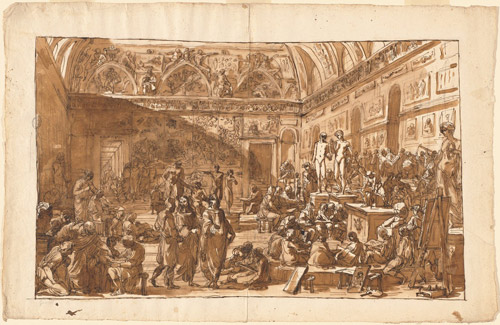
Felice Giani
San Sebastiano Curone (Alessandria), 1758–Rome, 1823
The School of Rome, c. 1795
pen and ink and wash over chalk
Pepita Milmore Memorial Fund, 2002.129.1

Tommaso Minardi
Faenza, 1787–Rome, 1871
Saturn Wrestling with a Snake, 1800s
pen and black and gray inks with wash over chalk
Gift of Jeffrey E. Horvitz, 2008.117.4
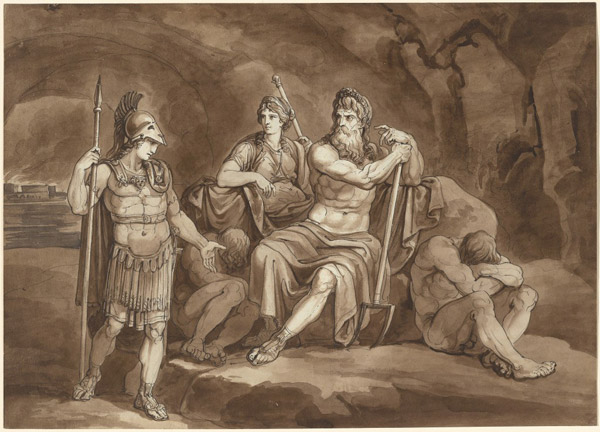
Bartolomeo Pinelli
Rome, 1781–1835
Telemachus Requests Permission from Pluto to Seek His Father in the Underworld, 1809
pen and ink over pencil with brown and gray washes
William B. O’Neal Fund, 2014.94.1
This unusual subject derives from a late seventeenth-century French novel in which the adventures of Telemachus, son of the Homeric hero Odysseus, serve as an allegory of education and the path to good governance. An early work by Pinelli, this vigorous drawing, with its knowing references to ancient statuary, reflects his training and early activity as a sculptor. Pinelli would go on to become a prolific illustrator of both classic texts—such as his illustrated Dante also featured in this exhibition—and of scenes of contemporary Roman life, featuring an elegant, almost purely linear style.

Luigi Sabatelli
Florence, 1772–Milan, 1850
The Four Horsemen of the Apocalypse, 1809–1810
etching
Ailsa Mellon Bruce Fund, 2011.124.1
The leading neoclassical painter in late eighteenth-century Florence, Sabatelli went to Milan in 1808 and became an influential professor at the Academy of Fine Arts. Upon arrival he undertook an ambitious project to interpret the Book of Revelation, a measure of artistic imagination ever since Albrecht Dürer published his famous series of woodcuts in 1498. The six resulting etchings, in a style combining meticulous draftsmanship with visionary fervor, remain Sabatelli’s most significant work as a printmaker. This plate illustrates some of the most famous verses from Revelation (6:1–8), which describe the opening of the first four of seven seals and the subsequent emergence of the four horsemen of the Apocalypse. They represent, from left to right, death, injustice, conquest, and war.

Luigi Sabatelli
Florence, 1772–Milan, 1850
The Four Horsemen of the Apocalypse, 1809–1810
pen and ink over chalk on wove paper backed with Asian paper
William B. O’Neal Fund, 2010.40.1
This drawing is virtually identical in scale, composition, and detail to the etching by Sabatelli on the left. On the one hand, this drawing cannot be a copy by another artist because the hand and quality are perfectly characteristic of Sabatelli. On the other, if the drawing had preceded the print as a preparatory study, one would expect to find slight differences between the two and the drawing’s orientation most likely would be reversed. Instead, the drawing appears to be one of numerous repetitions of both individual motifs and entire compositions that Sabatelli created for the many admirers of his draftsmanship.

Bartolomeo Pinelli
Rome, 1781–1835
Dante Flees the Wild Beasts and Meets Virgil, 1824
graphite on laid paper, mounted on nineteenth-century album sheet
Gift of Alexandra Baer, 2007.149.1
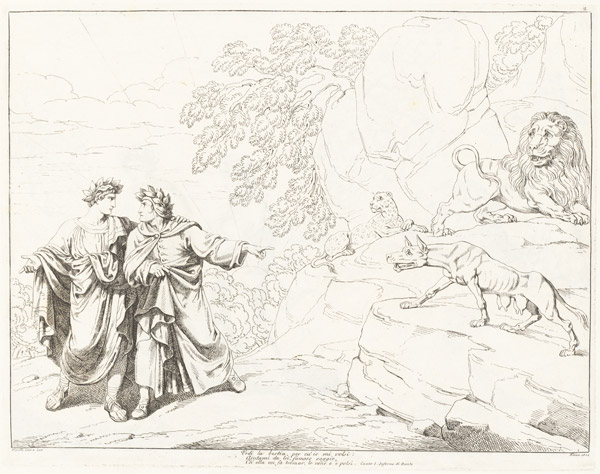
Bartolomeo Pinelli
Rome, 1781–1835
Dante Flees the Wild Beasts and Meets Virgil (“Vedi la bestia, per cu’io mi volsi . . .”), plate 2 in Divina Commedia di Dante, I: Inferno, 1824
etching
Gift of Dr. and Mrs. David S. Pollen, 1981.75.5
Pinelli’s late work was devoted to illustrating narrative texts, both ancient and modern, in a polished, linear style that represents his own variation on neoclassicism. One of his major projects was the illustration of Dante’s Divine Comedy in three folio volumes composed of 145 plates (1824–1826). This plate from the Inferno combines the scenes of the poet’s encounter with a leopard, lion, and she-wolf upon his descent into hell and the subsequent meeting with Virgil, his great precursor and guide, who warns, “You must go another road, if you wish to escape this savage place.” Pinelli’s swift preparatory study, on the left, determined the basic arrangement of the composition.
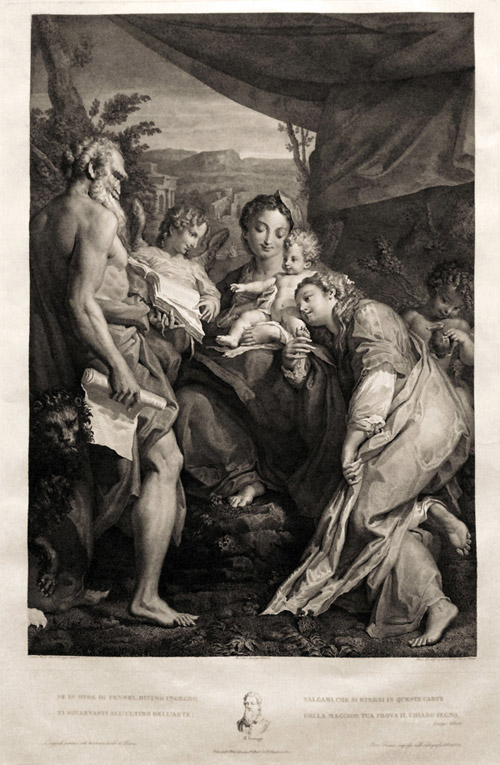
Mauro Gandolfi
Bologna, 1764–1834
Virgin and Child with Saints Jerome and Catherine and an Angel, after Correggio, 1826
engraving, proof before completion and letters
Purchased as the Gift of Matthew and Ann Nimetz, 2014.65.1
Correggio painted the so-called Madonna of Saint Jerome in the late 1520s for the church of Sant’Antonio, Parma. Ardently admired through the first half of the nineteenth century, it was engraved dozens of times. This print is usually judged to be the most successful at conveying the painting’s subtle tones, suffused atmosphere, and gentle sentiment. Gandolfi, the last figure in an important family of Bolognese artists, undertook this version at the behest of Giuseppe Vallardi, a leading dealer and collector in Milan who also composed the accompanying verse.

Fortunato Duranti
Montefortino (Ancona), 1787–1863
Falsehood Is the Source of All Evil (La bugia e causa di tutti mali) (recto), 1835/1845
pen and ink with wash
Wolfgang Ratjen Collection, Patrons’ Permanent Fund, 2007.111.71.a
The title of this print comes from the artist’s inscription along the lower edge. The scene apparently takes place in an antique setting, indicated by the statue on a pedestal, the temple facade, and the horse-drawn chariot at right. The connection between the inscription and this subject—like that between the disciplined composition and the agitated handling—is, however, difficult to ascertain, as is the allegorical meaning itself. Duranti’s work consists largely of such idiosyncratic, often strangely expressive drawings.
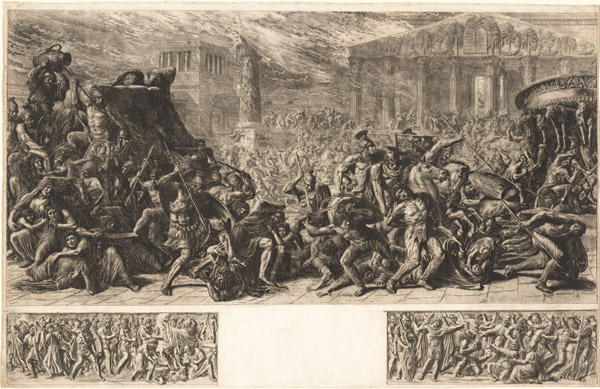
Luigi Ademollo
Milan, 1764–Florence, 1849
The Sack of the Temple at Jerusalem, c. 1838
etching and aquatint
Ailsa Mellon Bruce Fund, 2004.89.1
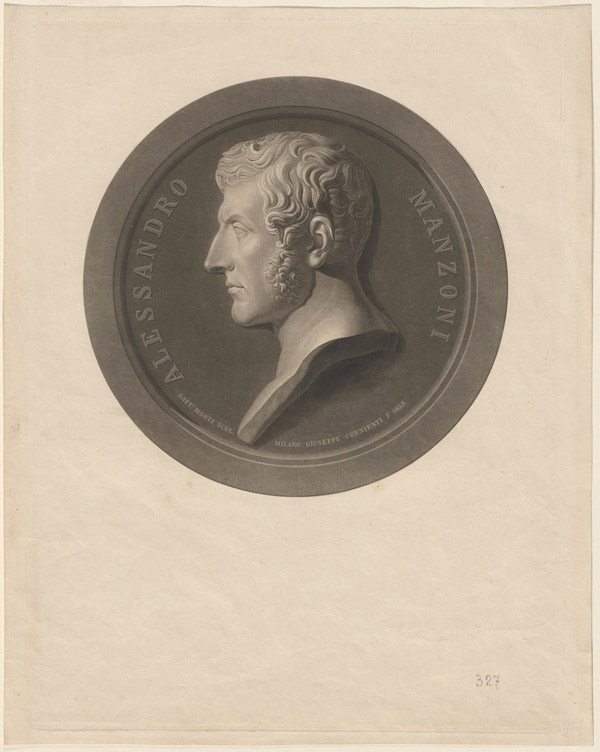
Giuseppe Cornienti
Pavia, 1797-Milan, 1870
Alessandro Manzoni, after Gaetano Monti, 1858
aquatint and roulette
Ailsa Mellon Bruce Fund, 2013.73.2
Alessandro Manzoni is generally regarded as the greatest Italian author of the nineteenth century and his principal work, the novel The Betrothed (1827), is a cornerstone of the modern Italian language. Even before its publication Manzoni had achieved fame with The Fifth of May, a lyrical poem composed upon the death of Napoleon in 1821. Its success was the inspiration for the sculptor Gaetano Monti’s marble relief portraying the author in the idealized neoclassical style made fashionable during Napoleon’s annexation of Italy (1805–1814). A quarter century later, Cornienti, an academic engraver, translated Monti’s portrait into this, his best known print.
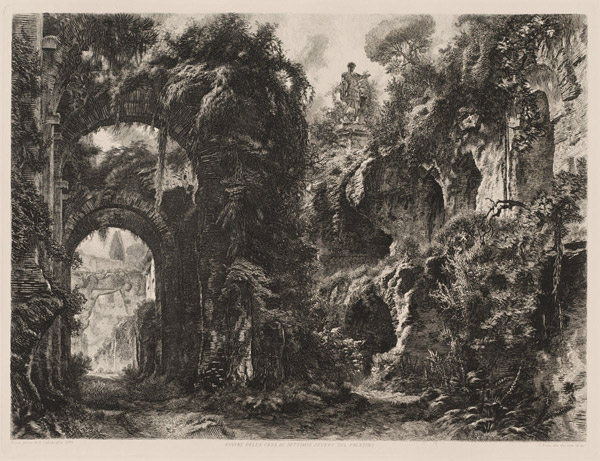
Cesare Biseo
Rome, 1843–1909
Ruins of the House of Septimius Severus on the Palatine (Rovine della casa di S.S. sul Palatino), 1900
etching
Ailsa Mellon Bruce Fund, 2013.171.6
A painter of oriental themes and an occasional printmaker, Biseo created this etching in tribute to the eighteenth-century artist Giovanni Battista Piranesi. The subject (an ancient Roman monument overtaken by time), the deep perspective, and the density of line all pay homage to Piranese’s etchings of Roman ruins. The print testifies to the long and powerful grip of the past on the Italian imagination into the twentieth century.